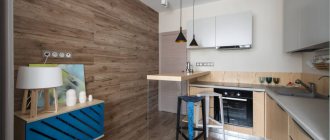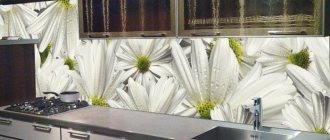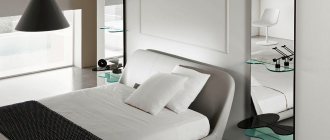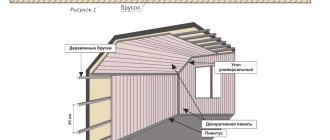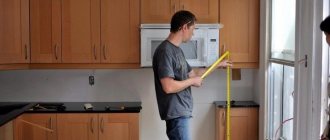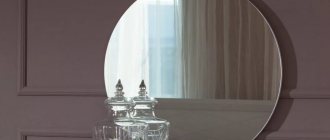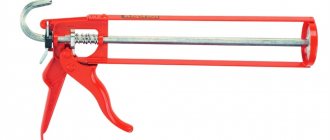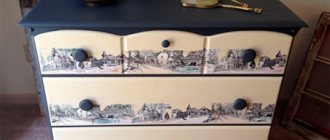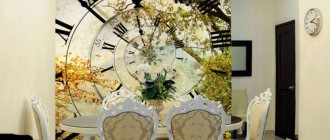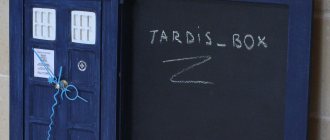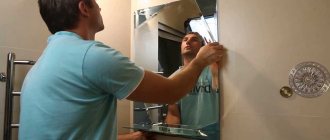How to hang a mirror? It would seem that the answer is obvious - using screws, hinges and other metal fasteners. But to do this you will have to drill into the wall, which is quite difficult and sometimes impossible. And then glue comes to the rescue
Liquid nails for mirrors
The very idea of gluing a heavy and fragile mirror looks quite risky. Of course, this cannot be done with simple universal glue. There are special mounting mixtures for mirrors, and their range is quite wide. So what should you choose?
Obviously, the glue that can fix the mirror must be strong and durable. It requires good adhesion to smooth surfaces, as well as resistance to deformation, humidity, and temperature changes. And of course, it cannot be so aggressive as to dissolve the amalgam (the reflective layer on the “underside” of the glass).
The first thing that comes to mind is the so-called liquid nails
. We are talking about glue with a special clay filler, which provides adhesion even to porous surfaces. Using this mounting mixture, the mirror can even be glued to a brick wall.
A relatively small mirror can be glued on your own, but if its area exceeds 1 m², it is better to entrust this work to professionals
Of course, the choice is not limited to liquid nails. The market offers us many special installation adhesives
. For example, “Tytan Professional for mirrors” from Selena, “Glue for mirrors 47A” produced by Soudal MirrorFix (Penosil), “Quelyd Mastifix for mirrors” (Bostik), “Mirror” (Krass), “Mounting glue for mirrors” (Poli- R). The average cost is 150-300 rubles. per package with a capacity of about 300 ml.
Adhesives for mirrors
Most mirror adhesives are based on synthetic rubber and resins in an organic solvent. This formula provides the material with high strength, durability, immunity to moisture and, unfortunately, a strong unpleasant odor. There are also acrylic water-soluble adhesives that do not have this drawback. Their disadvantage is that they are “hydrophobic”, which does not allow use in the bathroom or kitchen.
When choosing an adhesive, it is important to carefully read the information on the packaging. It is not advisable to use universal compounds, even those that allow working with glass - there is a risk of damaging the amalgam.
In an effort to reduce the cost of the material, manufacturers often add caustic substances to the formula that can dissolve the reflective layer. If the product is intended specifically for mirrors, there is no need to worry about this.
If you need to glue a relatively small mirror, you can use a car mirror sealant, such as acrylic-based Permatex or DoneDeal two-component silicone compound. Products of this kind are sold in compact, easy-to-use packaging and contain detailed instructions for use.
Methods for attaching a mirror to the wall
Large frames for this item are becoming irrelevant, and more and more often you can find the product “floating” in the air, which gives a feeling of lightness to the interior.
There are several options for hanging a mirror on the wall without mounting and invisible fittings, which will ensure safe operation and a beautiful design without a frame.
They contribute to the visual expansion of space and help to install special “diffused” light in the rooms.
Manufacturers offer special compounds that provide good adhesion to the surface, without drilling holes and fasteners.
It is very important to know how to correctly place a mirror on the surface chosen for this.
Sealant and glue
This is the simplest and safest method of fastening, but during installation you need to ensure a perfectly flat surface. A special adhesive-sealant will reliably glue a product of any thickness and size to the base.
The easiest way to install a mirror without a frame is to glue it to the surface using special glue.
The exception to this method is high humidity in the bathroom, smooth surface of ceramic tiles and decorative plaster.
When working with the composition you need:
- make markings in the right place for gluing accuracy;
- apply glue to the back surface of the product dotted in a checkerboard pattern or in stripes at equal intervals;
- press to the base for 5 minutes, if the mirror size is more than 1 m2, the product is fixed for 12-24 hours until the sealant dries completely.
Installation of reflective glass occurs in a matter of minutes.
When the glue has set on the surface, you can glue the decorative frame around the perimeter using the same composition.
The main thing is not to make a mistake with the location during installation. The composition quickly sets to the surface, and it will be impossible to remove the canvas from the wall; you will have to break it and remove it in parts.
If necessary, liquid nails can be used.
Special holders
They are used in the bathtub and on walls with an uneven surface, and during installation you cannot do without drilling holes, but it is the most reliable.
The brackets are fixed directly to the wall. They support the mirror from below or on the sides.
Types of holders and installation methods:
- Through, used when there are holes in the canvas. During installation, it is necessary to accurately drill the holes so that they coincide with the mounting points. Insert a special nail into the hole and thread the product onto the dowel. Such holders are made of chrome and stainless steel with plastic and metal decorative plugs that provide a strong fixation.
- Non-through, made in the form of a profile with plastic gaskets that support the blade from below and from the side for secure fastening. When installing, leave a gap of 2-3 mm between the product and the holder so that it fits freely into the grooves.
They differ in material of manufacture, design features and design.
This installation method is applicable to any base material, regardless of width and size.
Double-sided tape
It is used when installing a mirror sheet on a wall made of tiles, plastic panels and smooth plaster. If necessary, the product can be easily removed from the surface, leaves no marks and can be used in the bathroom.
Double-sided tape is an ideal tool for attaching small mirrors to a smooth surface.
Hanging the canvas with tape is very easy. You need to remove the protective tape from one side and apply it around the perimeter of the mirror on the reverse side, for reliability, add a cross-shaped element in the middle. Remove the protection from the second part and secure it in the desired place.
This is a great option when you need to quickly and effortlessly attach a mirror.
Important. When installing, you need to take into account the size and weight of the product. For fastening weights of 1-4 kg, tape is suitable; for more massive models of 4-10 kg, sealant or glue is needed. When installing large models, it is better to use holders that are designed for heavy weight.
Features of fastening to different types of surfaces
To ensure that the mirror stays well on the wall, you must adhere to certain recommendations during installation. They differ depending on the wall material, fittings and tools used. The weight that a particular wall can support is also important. Each individual case has its own nuances that you need to know:
- Concrete. To drill a hole for a dowel in such a powerful base, it is impossible to do without a hammer drill. When deciding to stick the product on a concrete or brick surface, it must first be coated with a primer, which will increase the adhesion of the mirror to the base.
- Drywall. The material is not particularly durable and cannot withstand heavy loads, so the weight of the mirror is limited to 20 kilograms. Holes are easily made with a screwdriver or drill. Butterfly dowels and anchor bolts are used as fastenings.
- PVC panels. Mainly used in the bathroom. This base is not suitable for heavy mirrors. Before installing the structure, preliminary preparation is required. It consists of mounting a sheathing on the wall, on which the canvas will be fixed.
- Tile. A mirror can be attached to such a surface in many ways. It is recommended to use drills for concrete, and even better for glass. When going deeper into the wall itself, reliability increases significantly. There may be differences in height between the tiles. To prevent it from interfering, a layer of plaster should be applied to the tile to level the surface. Another option is to install a sheet of plasterboard.
Mirror holders and installation methods
If after some time the mirror has to be removed/replaced, it is more convenient to install it on the holders. They are of two types:
- end-to-end;
- non-through (ordinary).
Blind-through mirror holders are installed on a wall or door. Then the edge of the mirror is inserted into them. They can be attached almost flush to the plane of the wall/door, or they can be remote-mounted. In the second option, a gap of 5 mm to several centimeters remains between the wall and the mirror. This saves you if you need to install it on uneven walls.
Beautiful ideas
An interesting hallway, where the entrance area is separated by a high cabinet, and on the other side there is a place to relax and put yourself in order. The full-length model was placed on the front of the closet, and the makeup product was equipped with lighting and hung on the wall.
A mirror can be used in any interior; its size, shape, location, as well as the style of the frame are important.
Some interiors successfully combine a mirror that reflects full-length and waist-length. A large product can be hung on the front of the door, and a compact product can be hung on the side wall. The glare of light from the lighting creates interesting special effects and makes the hallway brighter.
What glue to use
Determine exactly the composition with which the mirror will be attached. For this use:
- liquid Nails;
- special glue for mirrors.
To install mirror panels, you must choose a special glue that does not contain components that damage the amalgam (mirror layer). The most popular and frequently used mirror adhesive is Bostik 2750MS. The advantage of this glue is that the wall under it does not need to be primed. The adhesive has good performance characteristics and adhesion and can be used for gluing various surfaces.
In addition to this glue, brands such as SOUDAL, Abro and Tytan have proven themselves well.
When installing a mirror on ceramic tiles in the bathroom, it is better to choose a polymer and moisture-resistant adhesive.
How to hang a mirror without a frame on the wall
Of course, every person has a mirror in their bathroom, and before it can be found there, it will need to be somehow hung on the wall.
Of course, if a mirror has a frame, then it is equipped with a special device on this frame with which you can easily hang this mirror on the wall.
How to hang a frameless mirror on the wall
This is a really difficult question, although it can be done with your own hands.
Where can you hang a mirror?
First you will need to decide on a place where you can hang the mirror. The mirror should be hung only above the washbasin to make it convenient to use - approximately it should be located at a height of about 1.5 - 1.6 meters from the floor.
We hang a mirror on the wall.
In order to hang a mirror on the wall in the most common way, you will need to use the following tools:
— Hacksaw for wood; - Regular pencil; — Roulette; — Alcohol level; — Reiki made of alcohol; — The mirror itself; — Painting tape; — Double-sided tape for attaching the mirror.
Once these materials have been collected, you can begin the process of installing the mirror on the wall:
1) In relation to the washbasin, the height should be approximately 20 centimeters, although this also depends on the exact size of the mirror;
2) then, using a pencil and tape measure, you will need to measure this distance on the wall;
3) Prepare two supports - it is best to use wood for them - these should be two small planks that can hold the mirror for some time;
4) then you will need to make the same supports according to the measurements that were made earlier. To do this you will need to use a hacksaw for wood;
5) when the supports are ready, they will need to be installed in a vertical position, and they must be supported on the two extreme points of the sink. You need to check whether they really stand perfectly vertically using a spirit level. Then, using masking tape, you will need to fix these supports.
6) Then you need to glue a special tape to the back of the mirror itself, which is glued on both sides. In this case, the strips of this tape should be glued exclusively in a vertical position at a distance of approximately 15 centimeters from each other;
The most effective fastener
Luckily, there is an easy way to ensure that a heavy mirror stays in place. Its name is a little scary - “French thorns”. This fastening method uses interlocking screws angled at a 45-degree angle to hold an object in place on a vertical surface. The rigid, virtually flawless design has been used for hundreds of years to mount cabinets, heavy mirrors and large-format artwork.
Necessary materials:
- board 1.5×15 cm;
- wood screws;
- drill + chisel;
- table saw;
- level;
- pencil;
- measuring tape;
- hand saw.
On drywall
There are three ways - use glue, use double-sided tape or install dowels. In the latter case, special plastic butterfly inserts are used. They open up under the drywall when a screw is driven in. In any case, hanging items weighing more than 10 kilograms is not recommended. Drywall is a fragile base, which means that a large mirror will not be held securely. If the structure is heavy, it is better to provide and make a special stand, tripod, or use a floor mirror in a frame without mounting to the wall.
Installation work
You can use the services of a workshop that has the appropriate equipment. When making it yourself, use a drill or a diamond drill.
Installing a mirror on the wall in the bathroom is not very difficult.
It is only important to adhere to a certain algorithm of actions.
First, degrease the surface with alcohol. The hole is made at a distance of at least 30 mm from the edge. The tool is oriented perpendicular to the plane. Drilling is carried out starting at low, then at medium speed.
High tool speeds, pressure, work without cooling are unacceptable!
It is practical to arrange a rim of plasticine around the drilling area and pour water. The finished holes are cleaned with sandpaper.
How to mount a mirror on the wall is a completely solvable task; there are many ways to mount it.
Each has its own characteristics, the choice is made taking into account:
- Rooms (bathroom, living room, hallway - different in humidity levels and air speed);
- To the design (presence of frame, substrate, shelf, hangers);
- Dimensions and weights;
- Presence of holes;
- Material of the room wall;
- D permissibility of drilling with violation of finishing;
- From the falsehood of eliminating defects after removing the product.
A light mirror can be glued to a flat wall using liquid nails, treating the joints with sealant.
How to hang a mirror on the wall and not disturb it is the most important question for a bathroom, where every hole can ruin an expensive finish, but it is of little significance for a concrete, brick or plasterboard partition, on which traces of drilling can be easily and imperceptibly eliminated.
It should be remembered that the glue hardens very quickly, so the mirror must be leveled as quickly as possible.
If the product has holes, it is attached to the drywall with a “butterfly” type device; when hanging on a brick wall, a regular dowel is used. In the absence of drilling, mounting with glue or tape and reliable special fastenings such as staples are equally applicable.
There are many installation conditions and installation methods - there is an option for every situation.
Installation Tips
Although the process of installing a mirror on a wall cannot be called complicated, and you can do it yourself, you need to take into account some points when working with a mirror:
- When drilling, it is necessary to constantly cool the mirror at the drilling site. Otherwise, it may crack or burst due to high temperature;
- It is necessary to drill only with a diamond-coated drill, ordinary drills will crumble the canvas and the hole will be sloppy;
- finished holes must be cleaned or sanded to finish the edges;
- drill holes first for the lower fastenings, then for the side and upper ones;
- It is best to attach the mirror to drywall using hardware with a “butterfly” device;
- Instead of liquid nails, you can glue the mirror with neutral silicone sealant. In terms of cost and setting time, they are approximately the same, but acid sealants will damage the canvas. Therefore, it is necessary to carefully study the scope of use of each adhesive and sealant.
It is also necessary to take into account such features as:
- room humidity;
- the presence or absence of a frame on the mirror;
- dimensions, thickness and weight of the canvas;
- wall material in the room;
- permissibility of drilling walls or canvas.
How to hang
Having studied the features of choosing fasteners depending on the base, they proceed to direct actions, performing operations in accordance with step-by-step instructions. There are various ways to attach a mirror to a wall, differing in the level of reliability and the degree of intervention in the base.
Using glue and sealant
Hidden fastening using a special adhesive composition allows you to install panels weighing up to 10 kg. Glue and sealant practically do not damage the wall - if necessary, the mirror can be rehanged and the remaining glue can be removed.
The following is used as a fixative:
- special glue (Tytan, Bostik, Soudal, Abro, “Moment Montazh” and others);
- double-sided tape (suitable only for small products weighing up to 1-2 kg);
- silicone sealant;
- polyurethane foam.
If you are using a sealant or liquid nails rather than a special compound, you must make sure that the product does not destroy the mirror amalgam. Substances containing acids should not be used as they may damage the fabric.
First, the surface is cleaned of dust, wiped with a cloth moistened with any degreaser (alcohol or soap solution), and dried. After this, glue is applied. You can squeeze out the adhesive solution in a thin strip around the entire perimeter (snake) or pointwise, placing drops in a checkerboard pattern. If the mirror is heavy, the glue should cover the entire back surface.
After application, it is leveled with a fine-toothed trowel, which is used when laying cork. The usual one, intended for putty, will not work. Afterwards, firmly press the product to the base in a pre-designated area, hold the glue for the time indicated on the packaging and release. It usually takes about 5 minutes for the mixture to set.
Useful video
In a modern home, a mirror has long become an interior item or even a highlight of the room design. Mirrors are installed in the bathroom, in the hallway, in the living room and even in the bedroom. From time to time, mirror glass has to be removed in order to make repairs, hang wallpaper and lay tiles. After re-gluing the wallpaper, the mirror panels return to their original places, and the question automatically arises of how to attach the mirror to the wall with wallpaper.
Mirror with frame
Products with frames are easier to install on the wall than without frames. Usually, the frames themselves already have special slots that are placed on the dowels. Markings are needed on the bottom of the wall so that the mirror stands level and does not warp. If there are no slots, you can make them yourself.
If there are holes in the frame, the mirror is secured with screws using special holders. You can also contact a glass workshop and order a product with slots in the frame for mounting to a wall (or cabinet), or with holes in the mirror itself, along the edges. All that remains is to drill holes in the wall and use dowels with self-tapping screws for installation.
If the mirror is large in size, then a plinth must be placed on the floor. To prevent the mirror from falling down into the gap, you can additionally install a wort and a plastic corner on it for protection.
Then they proceed according to the usual scheme: calculations, markings, drilling and fastening. You should be attentive to fittings and materials so that they do not cause cracks.
You can make a baguette or a frame yourself if you wish. Then the mirror will fit into the interior much more harmoniously.
